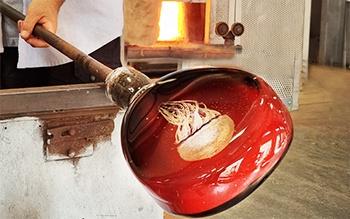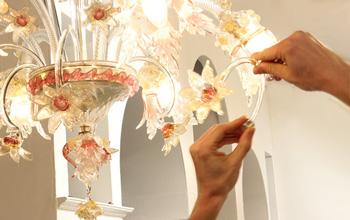One of the most ancient technique became one of the most recent, thanks to a paradox of history. That is, the glass fusion: the glass which born from glass, neither from the moulding of sand, soda, carbonate or various oxides in the powerful furnaces, nor the half-processed glass of the rod used in the lampworking art. Instead created from a material glass sheet, done and ended, which fragmented and recomposed according to a defined project, is melted and cooled again, alone or over other sheets.
But, as usual, let follow the order: a bite of history
The first archaeological evidences of such technique are dated at the beginning of the II millennium, between the Egyptian and Near East (Georgia and Syria), with finds as plates, vases, furniture, and ornamental objects. From the dawn of this technique – maybe accidental: 2 little glass sheets leave near flames which by error were liquefied and solidified united – has been develop throughout the decades and centuries a very refined tradition, which would have been resumed during the Roman ages.
From 1500 b.C to 500 a.D, in fact, this type of process has resulted very fashionable, according to a spread throughout the world from the Mesopotamian regions to all the Roman empire’s control, although after that disappearing from VI a.D century onward. The motif can be founded in the progressive developing of the glass-blowing technique, more fitted to the production of objects of daily use, as glasses, basic and elaborate crockery, ampoules, and jugs.
After roughly 14 centuries hidden, period through which all the techniques, even the most particular and originally of niche, were rediscovered and enter the market: eventually, the glass fusion has found a new way. We were already in the ‘70’s and about more than 10,000 km distant from its birth place – actually in a different world – precisely in the New one: The West Coast American artisans were the most creative and inspired which experiment and relaunch the first artworks realized by glass fusion.
The contemporary glass fusion, step by step
The modern electric or gas furnaces considerably simplify the production of artworks glass-fused, even if, in any case, the process is still very delicate and require much competence of the artisans who use such technique.
Usually, these furnaces measure internally at most 200cm x 100cm, thus the glass sheets realized from this technique barely overcome such dimensions. The task of these machineries is of gradually get the substance roughly at 820°C, that is the fusion point, for then let the substance becomes less and less viscous to solidifying again in the desired shape. A complete cycle prowls around 10-12 hours, in accordance to the dimensions of the glass surface, the type of glass which composed the previous one.
Many different objects can be created, from plates to decorated windows, from jewels to paperweight, but let take us as sample a generic ‘tableau’ made up of glassy pieces: the first step is, in any case, the planning with marker and cardboard. As if one is drawing a mosaic, from the soul of the starting imagine, one poses a beautiful female figure on a wooden background, drawing lines which divided subject and background in many parts of different dimensions.
Posing the cardboard on the glass sheet of the selected colour for the dress – previously meticulously cleaned - the possible threes and shrubs in the foreground were cut through the cardboard and the glass: the action is done through a tool called ‘tagliavetro’ or ‘diamante’ and it is a sort of halfway between a marker and a scalpel. In many cases, an expert master can draw the lines directly on the glass sheet – freehand – without using the cardboard.
Once reached this kind of mosaic, then the other parts are made in the same way. The glassy pieces are now put on a transparent glass sheet, compatible with the glass used: such sheet would perform the function of a paper sheet, designed to embrace all the subjects.
Through powdered metal oxides, each tie with a particular colour, the shades of the background are defined, dusting such material as icing sugar.
Another powder – called ‘distaccante’ – is the agent used as homogeneous and thin layer on the refractory surface within the furnace: as one can easily understand, the aim is to prevent the glass from sticking.
By now, as in a cooking recipe, everything is ready to turn on the oven. Continuing with the cooking metaphor, it is unquestionable that the expertise and the precision of the Murano masters, true top chefs of the glass, are the ingredients through by the best dishes can be done!











